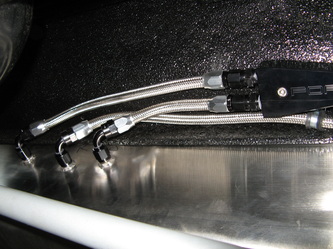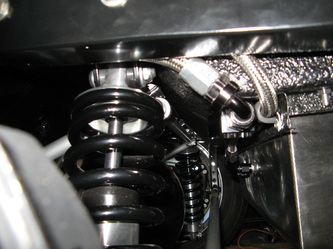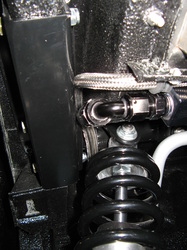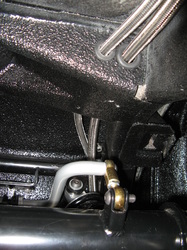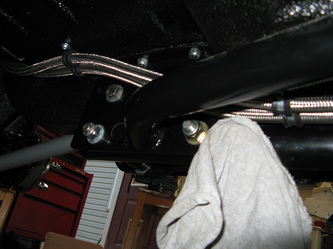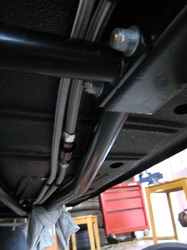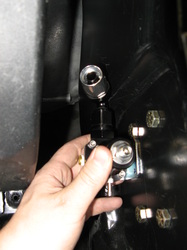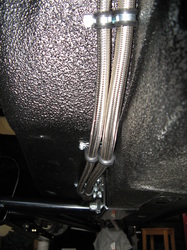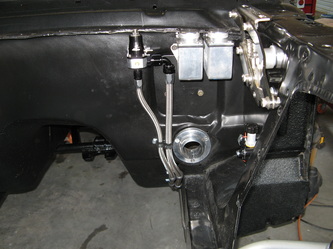Tale of two fuel systems
When I first bought my engine I got the entire fuel system and electrical harness out of the donor car. I was thinking that it would be easy just to drop it in and then hack the electrical harness up a bit to get what I needed off of it and then everything would be good. Well after taking with a few tuners here and there, they said it would be a nightmare to get the ECM to quit throwing error codes unless I had every emission module off the donor car, or about a week of tuner time to get it right. I certainly didn't have all the original modules and didn't really want to pay somebody a week of work where if I had the computer I could figure it out myself. I'm a electrical engineer by trade, so it's not that hard to me at least. Anyways, after some back and forth we finally settled on using Ford Racings engine control pack for the modular motors. I really wished I would of came across this module way before I bought this engine because I could of saved alot of money by not buying alot of modules I don't need anymore. But that's what hindsight it. So if anyone is thinking about this mod, it would be wise just pay the $1,800 for the Ford Racing Controls pack and save yourself the money for something else. Anyways here's how the fuel system went down.
The original GT500 fuel system used a returnless system. There were dual in-tank pumps that fed an in-tank Y-adapter which fed a single fuel line from the tank to the engine. At the engine there was a fuel pressure sensor that the ECM used to adjusted the fuel injector dwell time accordingly. In this system the fuel is never returned to the tank, hence returnless fuel system. The ECM actually uses a PWM signal to drive the fuel pumps at different speeds to keep the fuel pressure constant at the engine. PWM (Pulse width modulation) is a widely used way to efficently drive DC motors at different speeds. The idea is if you rapidly switched the power on and off to the motor you can control it's speed by varying the amoutn of "On" time versuses "Off" time. The more "On" time the more average power is given to the motor, thus the faster it will go. You can try this at home by placing a ceiling fan on high, then flipping the switch at the wall on and off at different rates (try a switching at least every second or so). Notice that if you leave the switch "on" for a longer period that you leave it "off" the faster the fan with spin. Anyways, so instead of a mechanical switch there is usually a MOSFET (a type of transistor which is the electronic equivalent of a switch), which is switched on and off at speeds in the thousands of times a second (kilohertz). If the PWM frequency is in the lower 20khz or lower you'll hear and audible pitch because the vibration of the motor will vibrate at the PWM frequency which in turn you can hear with your ears. Most high end servo drives run around 40khz to keep out of this audible range.
Anyways, the Ford Racing Controls pack require that you use a return-style fuel system. In this system there are no PWM drivers for the fuel pumps. The fuel pumps run at constant speed and pump fuel to a mechanical fuel pressure regulator which keeps a constant fuel pressure and diverts the excess fuel back down to the fuel tank. The fuel line from the engine is actually attached to the pressure regulator as a T-off from the pressured line. This in essence keeps the fuel line on the engine at a constant pressure. The OEM fuel pressure sensor on the fuel rail is still used, so the fuel injectors are driven correctly.
If that wasn't confusing enough here is the fuel's journey from the tank to the engine and back. I used Russell fuels lines for my system. I actually like their hose ends better than Earl's because they actually have a taper portion that actually threads into the hose to help you clamp it together. Where-as the Earl's you have to press very hard to get the ribs to go into the hose before the threads engage the hose nut.
The original GT500 fuel system used a returnless system. There were dual in-tank pumps that fed an in-tank Y-adapter which fed a single fuel line from the tank to the engine. At the engine there was a fuel pressure sensor that the ECM used to adjusted the fuel injector dwell time accordingly. In this system the fuel is never returned to the tank, hence returnless fuel system. The ECM actually uses a PWM signal to drive the fuel pumps at different speeds to keep the fuel pressure constant at the engine. PWM (Pulse width modulation) is a widely used way to efficently drive DC motors at different speeds. The idea is if you rapidly switched the power on and off to the motor you can control it's speed by varying the amoutn of "On" time versuses "Off" time. The more "On" time the more average power is given to the motor, thus the faster it will go. You can try this at home by placing a ceiling fan on high, then flipping the switch at the wall on and off at different rates (try a switching at least every second or so). Notice that if you leave the switch "on" for a longer period that you leave it "off" the faster the fan with spin. Anyways, so instead of a mechanical switch there is usually a MOSFET (a type of transistor which is the electronic equivalent of a switch), which is switched on and off at speeds in the thousands of times a second (kilohertz). If the PWM frequency is in the lower 20khz or lower you'll hear and audible pitch because the vibration of the motor will vibrate at the PWM frequency which in turn you can hear with your ears. Most high end servo drives run around 40khz to keep out of this audible range.
Anyways, the Ford Racing Controls pack require that you use a return-style fuel system. In this system there are no PWM drivers for the fuel pumps. The fuel pumps run at constant speed and pump fuel to a mechanical fuel pressure regulator which keeps a constant fuel pressure and diverts the excess fuel back down to the fuel tank. The fuel line from the engine is actually attached to the pressure regulator as a T-off from the pressured line. This in essence keeps the fuel line on the engine at a constant pressure. The OEM fuel pressure sensor on the fuel rail is still used, so the fuel injectors are driven correctly.
If that wasn't confusing enough here is the fuel's journey from the tank to the engine and back. I used Russell fuels lines for my system. I actually like their hose ends better than Earl's because they actually have a taper portion that actually threads into the hose to help you clamp it together. Where-as the Earl's you have to press very hard to get the ribs to go into the hose before the threads engage the hose nut.
Fuel Pumps
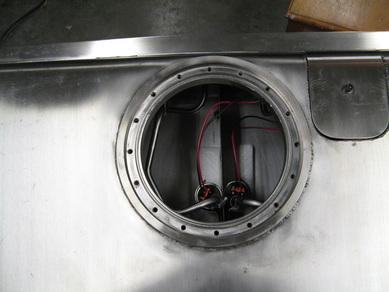
So the fuel run starts here in the tank. Here there are two Walbro GSS342 in-tank high-pressure fuel pumps. These each feed a -6AN fuel bung on the tank itself. If you look at the top middle of the opening you can see the return line as it dumps fuel right back into the tank.
Y-Block
The next trick is to combine the two fuel streams into a single stream. I picked this Y-block up from Fore Precision. They actually make a drop-in fuel hat for the GT500s with either two or three pumps. Instead of having a Y-junction inside the tank, Fore makes these blocks to bolt on the outside of the tank, allowing you to run larger fuel lines. I actually ran -6AN into the block and a single -8AN from the block downstream to the fuel filter. You can also see the -6AN return line tucked in there between the Y-block and fuel tank.
Fuel Filter
The biggest trick was getting the fuel lines from the Y-block to the fuel filter. This is fun that runs across the rear axle. I at first ran it right on top of the old shock mounts, but once I got my rear sway-bar back from the powder-coaters I had an clearance issue. So I had to drill four holes in the old shock mount to allow the fuel lines to pass through there. The front two holes weren't that hard to do. But the rear two were a pain in the butt. I basically have a right-angle attachment for my step drill along with a 1/4" extension to my drill. It was a total cluster, but it worked. I was bound and determined to drill those holes without dropping the rear axle. Well that at least got me across the old shock mounts. Then I had to route over and under the new shock mount. Basically the -6AN line fit through a nice little hole above the mount. But I had to run the larger -8AN fuel line right across the big bolts that bolt it to the frame rails. It actually came out nicer than I expected. Anyways, here is the run.
Fuel Pressure Regulator
I was trying to figure a good place out for this part, and it turns out that if I stick it right behind the drivers' cylinder head that I have a straight shot to the fuel rail inlet port on the engine. Turns out that having only two fluid reservoirs help out here. Here you can see just how close the engine sits to the firewall. Anyways, the inlet is the right-angle fuel line on the right-side of the fuel pressure regulator. The return line comes right out the bottom.
To the Engine
I haven't run this portion yet. I will once I get my car back from exhaust. I'm going to actually block out this port and fire up the fuel pumps to check for leaks and set the pressure before piping it to the engine.
